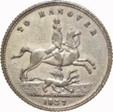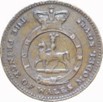TO HANOVER counters satirize the Duke of Cumberland’s ‘departure’ to Hanover. Although British monarchs from George I were also rulers of Hanover, Queen Victoria was barred under Salic law from succeeding to the Kingdom of Hanover, so the succession went to the nearest male heir, the unpopular Ernest Augustus, Duke of Cumberland.
The counters depict the Duke riding past a dragon (parodying St. George and the dragon) with the legend To Hanover. The Duke’s sword is usually upright against his shoulder, although sometimes it is sheathed. The dragon usually has three heads but occasionally one or two.
The obverse usually depicts a young head portrait of Queen Victoria facing left with legends such as Victoria Queen of Great Britain, H.M.G.M. Queen Victoria, Victoria Regina etc. In a few cases the manufacturer’s initials appear on the truncation. The counters are usually dated from 1837 to 1869 with only a few dated after that. Most of those dated after 1840 probably indicate the actual date of issue. A significant number have a fictitious date of 1830 and many of these, including those with the mis-spelling Quen, were made by the Nuremberg firm L C Lauer. In addition, some unusual and advertising pieces exist.
The vast majority are sovereign size with only about ten per cent half sovereign size. The half sovereign denomination was served by another popular series of counters at the time, the Prince of Wales Model Half Sovereigns (see below). About 350 varieties of To Hanover counters are known, with about 150 varieties of the Prince of Wales counters. Both are included in a checklist published in 20142.
However, To Hanover counters bore some similarity to gold sovereigns, especially after the reintroduction of the George and dragon reverse in 1871. This led to many prosecutions both in respect of their manufacture and for passing them as gold coins to unsuspecting victims. It was not, however, illegal to sell them (for an innocent purpose) until the Counterfeit Medal Act of 1883. This prevented the sale of “Medals” resembling current coin and led to the re-appearance of the spade guinea series of counters (see separate entry on this series).




PRINCE OF WALES MODEL SOVEREIGN & HALF SOVEREIGN counters were first issued shortly after Edward, first son of Queen Victoria, became Prince of Wales in late 1842, a month after his christening. He held the title of Prince of Wales for 59 years before ascending the throne as Edward VII in 1901.
The counters were extremely popular and continued to be issued by various manufacturers until the 1870’s. The majority were half sovereign size, complementing the mainly sovereign size To Hanover counters (see above).
The normal obverse is a young head portrait of Queen Victoria with legends such as Victoria Regina or variations of Victoria Queen of Great Britain.
There are three main reverse types –
The Prince of Wales emblem of three plumes and a coronet enclosed by a garter inscribed Honi Soit Qui Mal Y Pense with no outer legend.

Three plumes and a coronet with a ribbon on either side inscribed Ich and Dien, enclosed by a crowned circular frame. The circular frame is usually made up of two or three concentric circles with seven or eight ornaments or blocks. The outer legend is The Prince Of Wales Model (Half) Sovrn

The Prince of Wales on horseback enclosed by a crowned garter inscribed ICH DIEN, with outer legend of The Prince Of Wales Model (Half) Sovrn

The Counterfeit Medal Act of 1883 effectively put an end to the sale of Prince of Wales counters.
Full information is available in a published checklist of Imitation Sovereigns and their Fractions – ‘TO HANOVER & PRINCE OF WALES COUNTERS’ by Martin R Warburton & W Bryce Neilson – available from Galata Print Ltd. This 2014 publication lists over 500 varieties with many photographs and a guide to rarity/value.
Martin R Warburton November 2019
